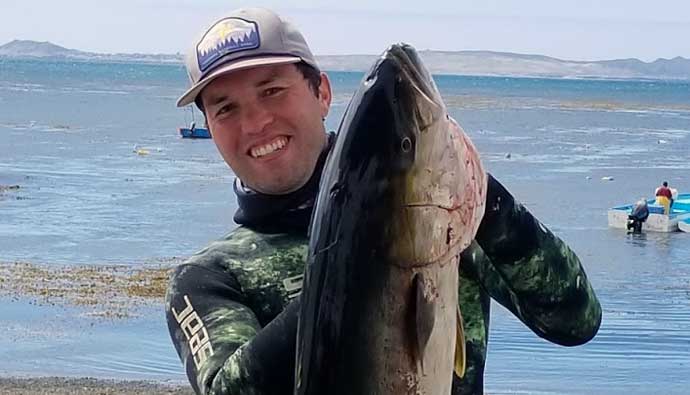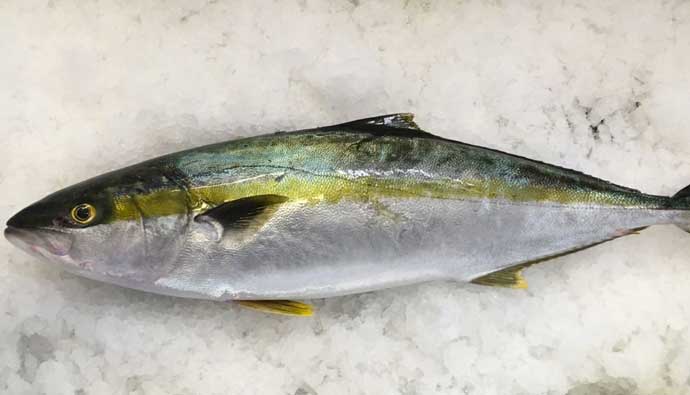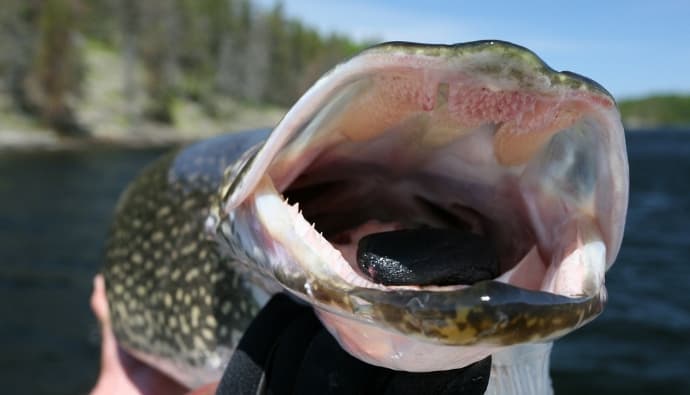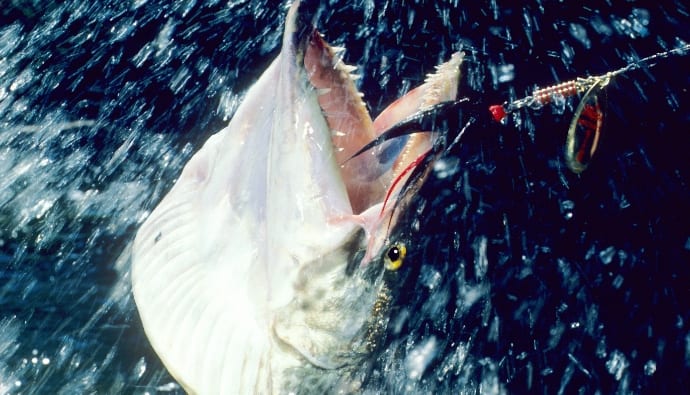The yellowtail (kingfish) is a prized fish to catch down the coast of California and into Baja.
Also known as the kingfish, yellowtail kingfish, amberjack, yellowtail jack, and king yellowtail, this fish is a member of the Carangidae family. However, anglers usually categorize them into three different species namely southern yellowtail, California yellowtail, and the Asian yellowtail.
These are plentiful in the Pacific, Atlantic, and Indian Oceans.

In this article, we’ll discuss yellowtail facts, how to catch them, cook them, and how to prepare them. Let’s dive in!
Recommended Gear:
- Yellowtail Rod: Penn Carnage II Boat Casting Rod
- Yellowtail Reel: Penn Fathom 40
- Yellowtail Lures: Nomad Design Madscad
Yellowtail Fish Facts
This fish is usually found in inshore waters and right out in the continental shelf. They also frequent deep waters around wharves, jetties, as well as other submerged man-made structures such as sunken ships and artificial reefs. Some may venture out along the shoreline, but larger specimens usually frequent deep waters around rocky cliffs.
Yellowtail usually spawns when it is about two to three years of age and the eggs hatch in two days. The fish travels in large schools around coral beds and reefs and will rise to the surface en masse to feed on baitfish. Plus, yellowtail tastes buttery and has a mildly sweet flavor.
These usually feed on whatever’s available, but their main diet consists of smaller fish, squids, and crustaceans. Larger yellowtail fish have been known to tackle tuna and bullfish as well. This fish is threatened by overfishing, so much so that at one time only one colony remained in the state.
| Scientific Name: | Seriola lalandi |
| Common Name(s): | Yellowtail Amberjack |
| Family: | Carangidae |
| Characteristics | Deeply forked, bright yellow caudal fins with a silvery belly and dark back |
| Depth Range | 3 to 825 meters |
| Where Found | Found in tropical and temperate waters |
| Catch Limits | Check your local regulations |
How to Catch
When it comes to yellowtail fishing, you can use both artificial and natural bait as well as trolled and jigged lures. They love live bait such as jack mackerel, koheru, flying fish, squid, and piper, but live kahawai can be used to bait larger varieties.
However, you can also use a soft plastic or large lures that can be retrieved quickly.
When searching for the best yellowtail lure to attract this quick fish, speed is the key to success. Yellowtail is attracted to fast objects or erratically moving lures since it confuses them as insects or small fish. To increase your chances of success, use mechanical jigging and vertical, high-speed jigging that can bring the fish to the surface fast.
The tackle you use should depend on the size and strength of the yellowtail fish you want to catch. Large ones require a heavy tackle that won’t break as this powerful fish struggles. As for lines, if you are using live bait or trolling, use a 30 to 80 pound one and if you opt for vertical jigging, use an 80-pound braid. If you are using soft bait on the other hand, use a light line.
Yellowtail Fishing Tactics

- If you see a school on the surface, try your saltwater fly fishing setup and toss some surface poppers at them. This isn’t for everyone, but it does add a new dimension to your sport.
- Kingfish are incredibly strong irrespective of their size. If you try to fight it, it will be hard on you as well. Don’t pull in too forcefully so that the fish doesn’t get alarmed and try to struggle. Allow it to swim out to deeper water so that you put on drag slowly but surely.
Fishing Tips
- Gloves can be handy for casting, especially for yellowtail fish which can take a while to reel in. Holding the braid for that long when you are casting can damage unprotected hands.
- If you are deep water fishing for a yellowtail, use the deep jigging technique with heavy metal lures to attract the fish to the surface.
Spearfishing Yellowtail

If you have the chance to go spearfishing for a yellowtail, you’re in for a treat as it is one of the most common target fish in SoCal, along with Bonito fish, Opaleye, Sheephead, and a few others. If you go for them in Southern California, it’ll be a bit harder than if you go down to Baja. Catalina and the various islands in Southern California can be fruitful.
We highly recommend you go down to Baja. It’s not uncommon to be walled by schools of yellowtail…so many in fact that you can get bored of shooting them.
Catching in All-Four Seasons
Spring
Yellowtails are active in March during the spring and can be caught using live bait such as mackerel and sardines.
Summer
Yellowtails are abundant in late spring and early summer and can be found 60 miles from the shore.
Fall
Catch yellowtail in the fall with jigs, live bait, and topwater irons.
Winter
Use live squid to catch yellowtail in the winter to get them to bite
How to Clean Yellowtail Fish

- Place the yellowtail with its belly facing you and hold the head with your left hand. Use a sharp knife to cut diagonally from top to bottom behind the pectoral fin.
- Turn the knife as you get to the bottom and continue along the center of the belly.
- Once you pass the belly continue cutting just above the anal fin and right up to the tail. Since you will be cutting through the skin keep the knife shallow at the first pass. Use several more passes to separate the meat from the bone as far from the spine as possible.
- Cut down through the tail till you hit the spine.
- Turn the fish around so the top is facing you.
- Use the tip of the knife to cut above the dorsal fin and keep cutting in the same line but perpendicular to the cut you made in the tail.
- Use your knife to separate the meat from the bones on this side as you did on the first side. Lift the separated section of the meat as you cut so you know where your knife is headed. Do the same at the cut you made in the tail.
- Forcefully cut through the rib bones by hitting them low on the blade to break it. Do the same on the other side, and you will be left with slabs of meat.
How to Cook

Yellowtail Recipe
- Butterfly a slab of yellowtail and spread it open skin down on the foil.
- Season with salt and pepper.
- Brush a mixture of melted butter and the juice of 1 lemon on the seasoned fish.
- Cook the fish on a hot grill skin down for about 10 minutes or till you think it is cooked through. If the flesh flakes off when you lift it with a fork it is done.
- Add chopped herbs in melted butter and brush over the cooked fish and drizzle more lemon juice on top before serving with a side of your choice.
Yellowtail Sashimi
If you want to try raw yellowtail fish, then I recommend you watch a few videos on YouTube to see how they make sashimi. Just be sure your fish is free of worms and other pests and remember that there’s always a risk when eating raw fish.
Be safe, but I must say, it is mighty tasty!
Frequently Asked Questions
It has a subtle buttery taste with hints of banana. It tastes like fish that belongs to the mackerel family but it is much milder.
The two fish species are often confused with one another but the main difference is that the yellowtail is a cousin to the Amber Jack while yellowfin tuna is a tuna fish that grows to enormous sizes. Both have similar-looking yellow tails which are where the confusion lies.
It is also known as the kingfish, yellowtail kingfish, amberjack, yellowtail jack, and king yellowtail.
Final Thoughts
The mighty yellowtail may be a powerful fish to catch, but it can be conquered with the right bait, tackle, and lures.
Check out the ones mentioned above and try them out yourself or if you have tips and tricks that worked for you share by commenting below.
Feel free to share this information with other anglers and newbies who want to try their hand at catching this fish.





 Facebook
Facebook YouTube
YouTube








